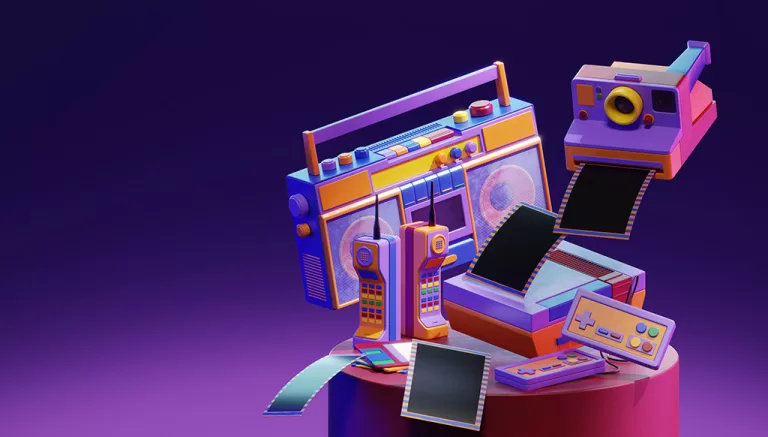The good old days. That’s what many brands are turning to these days to forge deeper connections with audiences: nostalgia, a potent emotional tool.
This approach, known as nostalgia marketing, involves evoking cherished memories–sights, sounds and experiences–from the past to create a resonant and emotionally charged relationship with consumers. It offers audiences a comforting escape and a bridge to simpler times through the revival of iconic products and ad campaigns and the incorporation of retro aesthetics, among other tactics.
With its unique blend of sentimentality and familiarity, nostalgia is being harnessed by brands to cut through the noise and gain an edge in an extremely competitive marketing environment. By blending the fondness of yesteryears with contemporary marketing techniques, brands can resonate with both long-time followers and a new generation of consumers.
What is Nostalgia in Marketing?
Nostalgia marketing is the practice of tapping into cultural references, positive memories, imagery, music and even product packaging from the past to create a sense of familiarity and trust among consumers. It typically involves reviving discontinued products, incorporating retro design elements or reimagining classic ad campaigns.
This type of marketing has been used effectively by brands such as Pepsi, which celebrated its history with youth culture in a series of brand activations and an anniversary campaign, and Timberland, which marked the 50th anniversary of its iconic yellow boot with a documentary and subsequent activations.
Nostalgia marketing can be achieved through a variety of tactics and channels, including the following:
- Rebooting or relaunching classic products, such as McDonald’s bringing back the McRib or Nintendo re-releasing its NES console.
- Using iconic imagery or slogans: for example, Coca-Cola’s “Share a Coke” campaign featuring popular names on bottles.
- Partnering with celebrities or cultural influencers from specific eras, such as Adidas featuring Run-DMC in ad campaigns.
- Creating content that awakens nostalgic feelings, such as Apple’s “Think Different” campaign showcasing historical figures or Samsung’s “Life is Good” commercials reminiscent of classic sitcoms.
Why More Brands Are Using Nostalgia in Marketing
Nostalgia marketing is becoming more prevalent because of its ability to create a powerful emotional connection with consumers and influence purchasing decisions. Nostalgia campaigns provide an escape from the constant influx of new products and innovations, allowing brands to stand out in a crowded market.
Factors driving the rise of nostalgia marketing:
- Evokes positive emotions like happiness, comfort and belonging, creating a strong brand association.
- Capitalizes on shared cultural experiences, promoting a sense of community and belonging within the target audience.
- Offers a sense of comfort and security in times of uncertainty or change, making brands appear stable and reliable.
- Facilitates differentiation, helping brands stand out in a crowded marketplace.
- Boosts brand recognition and recall with familiar references trigger memories that make brands readily identifiable and memorable.
- Increases credibility and establishes instant trust by leveraging familiar references.
- Allows for cross-generational appeal among different age groups, connecting new and existing audiences.
- Enhances brand loyalty by reminding consumers of positive past experiences with the brand.
- Drive sales and engagement as consumers are more likely to purchase from brands they feel connected to.
By revisiting the past, brands can share their journey and commitment to enduring values, fostering a deeper connection with consumers who appreciate authenticity and longevity.


Challenges of Using Nostalgia in Marketing
Despite its advantages, nostalgia marketing must be used carefully to avoid pitfalls such as over-reliance on past successes, which can lead to unoriginal or uninspired products. Additionally, if not integrated with contemporary elements, nostalgia marketing can alienate younger audiences who may not relate to the references.
Another challenge brands face is targeting the right audience. Different generations connect with distinct cultural touchstones, so aligning the nostalgic elements with the target demographic is crucial. Achieving authenticity, too, can be difficult. Inauthentic attempts at nostalgia can backfire, with consumers feeling deceived or manipulated.
When using nostalgia marketing, brands should be very careful to avoid overused symbols and clichés. Excessive use of nostalgia can become predictable and lose its effectiveness. Furthermore, they need to pay close attention to potential negative associations. Nostalgia can elicit unintended memories or cultural sensitivities. Careful research and execution are essential.
Final Thoughts
In an era of constant innovation and digital disruption, brands are increasingly turning to the past to forge deeper connections with consumers. Nostalgia marketing, the practice of reinforcing marketing campaigns with positive memories from bygone eras, is experiencing a surge in popularity, offering a new way to captivate audiences and influence purchasing decisions.
To be successful, nostalgia marketing must be authentic, show a clear understanding of the target audience, and deliver a seamless blend of the past with the present. By tapping into the emotional power of shared memories, brands can create lasting impressions and secure their place in the hearts and minds of consumers.


